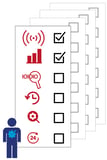The Benefits of Forecasting in Planning and Production
Nick Ostdick - March 29, 2018

If there’s one thing today’s planners and managers wish they had to ensure their planning and production strategies, it would be a crystal ball. A magical ability to glimpse into the future in order to cut the complexity and uncertainty of modern manufacturing and provide a path of stability and certainty in a variant-rich value stream. While a crystal ball is obviously an impossibility, planners and managers do have a critical tool to help predict future planning and production needs while at the same time managing inventory levels and job allocation strategies for maximum efficiency and productivity.
Forecasting. Or, in other words, the ability to see into the future and make educated predictions about any number of production elements such as material sourcing, job allocation, transport logistics, and more. In fact, forecasting is such an increasingly valuable proposition for manufacturing companies that a study by Gartner indicated forecasting (and the accuracy thereof) and demand variability were two of the greatest obstacles manufacturing companies encounter when overseeing their supply streams.
In addition, this same report indicated accurate forecasting was one of the top most priorities for manufacturing companies as modern manufacturing continues to develop, diversify, and expand to new regions of the world. Whether you’re concerned with demand forecasting (projections based on current industry demand or level of use for a given product) or supply forecasting (data about current production trends and the factors that might influence or impact these trends), companies need to be aware of how and why forecasting is such a critical operations.
With this mind, let’s examine a handful of ways forecasting is a critical value proposition for planning and production in today’s modern manufacturing landscape.
More effective production scheduling
So much of contemporary demand planning strategy can be compared to looking in a rearview mirror. Yes, where you’ve been can often help determine where you’re going, but that doesn’t necessarily help you avoid a multiple-car accident on the freeway. However, forecasting gives companies the ability to see into the future to avoid this hypothetical accident via more effective production scheduling to meet customer demands and market forces, and to align with the availability of raw materials and component parts. Because forecasting gives manufacturing companies a leg-up on these elements of planning and production cycles, companies can operate with more agility, transparency, and flexibility to adapt to changing production environments or schemes.
Inventory management and reduction
If a manufacturer can better understand and predict demand or orders for certain products, then they can more effectively work with suppliers to achieve optimal inventory levels to reduce the likelihood of part overages or shortages. Forecasting capabilities provide manufacturing companies the clarity of supply situations to more accurately evaluate the level of customer demand versus the volume of component parts necessary to successfully fill orders and ensure scheduled delivery windows. Not only does inventory reduction decrease the amount of warehousing or container space, it also helps companies streamline their operations by eliminating costly losses by significantly reducing the amount of time unused inventory sits in a warehouse.
Cost reduction
We just discussed how forecasting reduces the costs associated with unused materials or components parts, but forecasting also helps companies reduce costs by providing companies the foresight to not order more stock than necessary to fulfill customer orders. In addition, forecasting helps reduce costs associated with a number of other critical production tasks such as job allocation and management, sourcing raw materials, and even some front-office or customer-facing duties. Because forecasting impacts the production cycle from start to finish (and because production cycles impact each touch point of the value chain), a more efficient and cost-effective production platform means a more efficient and cost-effective manufacturing company.
Optimized transport logistics
Imagine Manufacturing Company A is reviewing their transport logistics only to reveal massive costs associated with transporting a certain volume of product to a certain location. In order to curb or even reduce these costs, this company tries to combine shipments or methods of transit, or perhaps even alter delivery dates based on customer demand. While these might be decent options, forecasting allows companies to take this one step further and systematically analyze their transportation strategy to identify areas where efficiencies can be increased and redundancies eliminated. Because effective transport logistics are about the fastest and most efficient way to move products from Point A to Point B, forecasting allows companies to see when, where, how, and why the most strategic transport decisions can be executed and the value these actions add to their supply logistics.
Increased customer satisfaction
Customer satisfaction in today’s global manufacturing industry is really about making sure the customer has the right product in their hands at the right time and how this product arrives to meet the customer’s needs. If we take forecasting to be a holistic method of refining, streamlining, and enhancing a manufacturing company’s operational, logistics, and production cycle platforms, then it makes sense how forecasting works to increase customer satisfaction and promote growth and expansion in the short, mid, and long-term.
If you want to learn more get your Guide to Demand Capacity Management:
LATEST POSTS
- Understand Why Production Planning Needs Specialized Solutions
- Understand Circular Economy in The Manufacturing Industry
- How Can Industry 4.0 IT Integration Be Achieved Smoothly?
- The Significance of Order Sequencing in Discrete Manufacturing
- How to improve your Supply Chain Management: The Power of Control Towers



